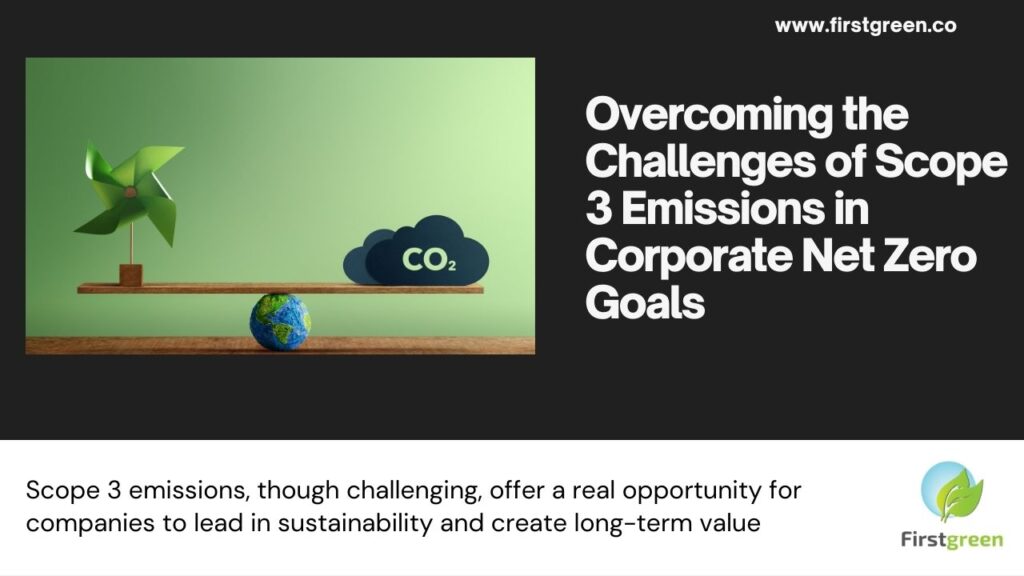Overcoming the Challenges of Scope 3 Emissions in Corporate Net Zero Goals

As companies around the globe strive to meet their net zero commitments, the focus on Scope 3 emissions has become increasingly prominent. Scope 3 emissions, which encompass indirect emissions from a company’s entire value chain, present unique challenges that can be difficult to navigate. Below, we explore five key challenges associated with Scope 3 emissions and discuss strategies for overcoming them.
1. Complexity of Measurement
Scope 3 emissions cover a wide range of activities that are often outside of a company’s direct control, such as emissions from suppliers, product use, and even waste disposal. This vast and complex category requires gathering data from numerous sources, each with varying levels of accuracy and transparency. To address this challenge, companies need to invest in robust data collection systems and collaborate closely with suppliers and partners to ensure accurate reporting. Additionally, adopting standardized methodologies, such as those outlined in the Greenhouse Gas (GHG) Protocol, can provide a consistent framework for measurement.
2. Data Availability and Quality
One of the most significant challenges in Scope 3 accounting is the availability and quality of data. Many companies rely on industry averages or estimates rather than primary data, leading to potential inaccuracies in emissions reporting. To improve data quality, companies should engage their suppliers and customers in the reporting process, providing them with the tools and knowledge necessary to accurately measure and report their emissions. This can include capacity-building initiatives and investments in technology that facilitate real-time data sharing.
3. Supply Chain Engagement
Engaging suppliers to accurately report and reduce emissions is often challenging, particularly for companies with extensive and global supply chains. Suppliers may be at different stages of their sustainability journey, with varying levels of commitment to reducing emissions. Companies can address this by establishing clear expectations and incentives for suppliers, such as incorporating sustainability criteria into procurement processes or offering financial incentives for emission reductions. Building long-term partnerships with suppliers focused on sustainability goals can also drive collective progress.
4. Regulatory and Reporting Requirements
The evolving regulatory landscape around emissions reporting presents another challenge. As governments and international bodies introduce new regulations and reporting requirements, companies must stay informed and adapt their reporting practices accordingly. The introduction of mandatory disclosure requirements, such as those from the U.S. Securities and Exchange Commission (SEC) or the European Union’s Corporate Sustainability Reporting Directive (CSRD), means that companies must be diligent in ensuring compliance. Regularly reviewing and updating reporting practices in line with emerging regulations is crucial to maintaining transparency and avoiding potential penalties.
5. Customer and Investor Expectations
As investors and customers become more aware of the importance of Scope 3 emissions, they are increasingly demanding transparency and action from companies. This pressure can drive companies to set ambitious targets but also adds complexity to meeting those targets. Clear communication and regular updates on progress are essential to managing expectations and building trust. Companies should also prioritize innovation in low-carbon products and services to meet the growing demand for sustainable options, which can ultimately lead to reduced Scope 3 emissions.
Conclusion
While Scope 3 emissions present significant challenges, they also offer opportunities for companies to lead in sustainability. By addressing the complexities of measurement, improving data quality, engaging the supply chain, staying ahead of regulatory requirements, and meeting customer and investor expectations, companies can not only achieve their net zero goals but also drive broader positive impacts across their industries. As we move toward a low-carbon economy, tackling Scope 3 emissions will be a crucial component of any comprehensive sustainability strategy.